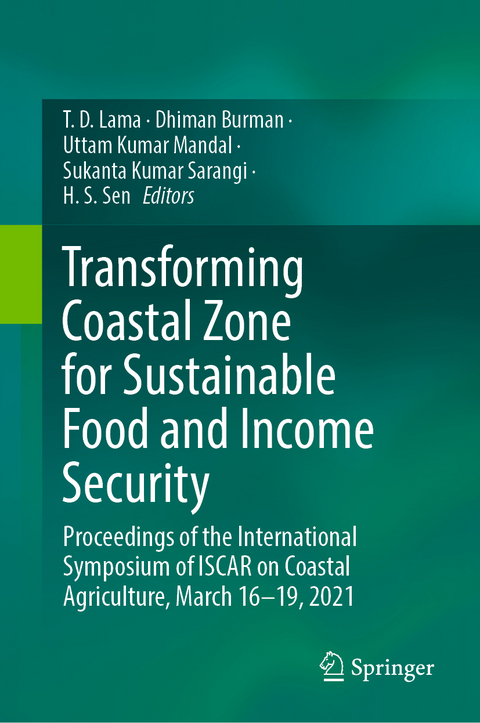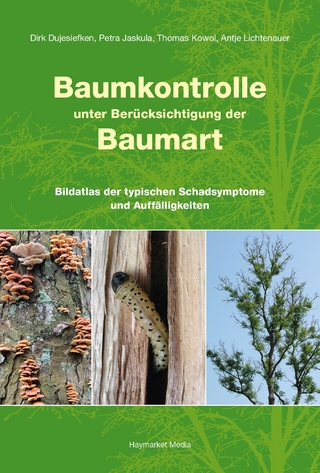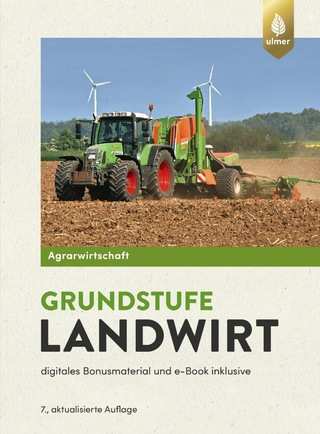
Transforming Coastal Zone for Sustainable Food and Income Security
Springer International Publishing (Verlag)
978-3-030-95617-2 (ISBN)
Coastal areas are commonly defined as the interface or transition areas between land and sea, including large inland lakes. Overall, about 50-70 % of the global population live within 100 km of the coastline covering only about 4 % of earth's land, thereby drawing heavily on coastal and marine habitats for food, building sites, transportation, recreational areas, and waste disposal. The people of these zones depend mainly on low productive agriculture due to several constraints such as prolonged water logging and drainage congestion in predominantly low-lying areas with heavy soils during the wet season, preponderance of saline and acid sulphate soils, scarcity of good quality irrigation water, particularly in the dry season, seawater intrusion into adjoining lands, and water pollution due to eutrophication, and others affecting the aquatic habitats, etc. Carbon sequestration in coastal areas, such as, marshes, lagoons, etc. has significant influence on soil quality, and the carbon pool in soils as well as their impacts on the environment. Over and above these, the coastal areas are prone to disasters due to climate change leading to colossal loss of lives and properties in many areas. Forestry and mangrove dynamics, in particular, because of their continuing diminishing nature, are also subjects of interest affecting the ecology of coastal zones requiring appropriate attention. The international symposium held in this context on ' Transforming Coastal Zones for Sustainable Food and Income Security ' in virtual mode in March, 2021 offered scope to present and discuss various thematic areas by eminent scientists from all over the world. The proceedings of selected papers presented reflect cross-sectoral views of the areas highlighting, wherever necessary, a fusion of technologies, with the ultimate target to suggest livelihood security and sustainable development for the sensitive coastal zones. The book intends to share the knowledge with researchers, academicians, and various other stakeholders to address the complex problems of coastal regions, production constraints, social, economic, technical and environmental issues to draw out strategies for resilient agricultural technologies and improving livelihood security in coastal agro-ecosystems.
lt;b>Dr. T. D. Lama is a Principal Scientist (Soil Science) at ICAR-Central Soil Salinity Research Institute, Regional Research Station, Canning Town, West Bengal, India. He holds a Ph.D. in Agricultural Physics from Indian Agricultural Research Institute, New Delhi, India. His current research interests are in the area of soil and water management in coastal saline ecosystem, hyperspectral remote sensing of salinity stress in rice crop and mapping of coastal saline soils using remote sensing and GIS. Earlier he had worked as a member of an inter-disciplinary team for assessment and demonstration of technologies for sustainable management of natural resources and livelihood improvement of the farmers in the North-eastern hilly region of India. He has also worked on evaluation of resource conservation technologies and water management for improving resource use efficiency in vegetable crops. He was a member of the team for demonstration and refinement of technology of low cost rain water harvesting structures and in-situ residue management for soil moisture conservation under Farmers Participatory Action Research Programme in North East Hilly Region, funded by DST, Govt of India, for which the Ground Water Augmentation Award 2008 under the Institution category was bestowed by Ministry of Water Resources, Government of India to the implementing Institute. He has authored over 40 research papers, conference papers, book chapters, bulletins and technical articles.
Dr. D. Burman is the Head and Principal Scientist (Soil Science) at ICAR-Central Soil Salinity Research Institute, Regional Research Station, Canning Town. He received his Ph.D. in Agricultural Physics from IARI, New Delhi. Since 1995 he is engaged in research at various scientific positions at ICAR institutes (Indian Grassland & Fodder Research Institute & Central Soil Salinity Research Institute) on sustainable management of problem soils in semiarid and coastal region for augmenting agricultural production. Having 18 years of research experiences on soil and water management for agricultural development in the coastal salt affected region. He has developed many agricultural technologies especially for small and marginal farmers of the salt affected coastal region. During his research carrier he has handled many in house research projects and international projects funded by GEF, CGIAR under CPWF, BMGF, IRRI and ACIAR as Principal Investigator/ Co-Principal Investigator. He received Jawaharlal Nehru Award of ICAR and Young Scientist Award of Indian Science Congress Association. He was awarded Fellow of Indian Society of Coastal Agricultural Research. He has several publications in national and international journals.
Dr. Uttam Kumar Mandal is a Principal Scientist in Soil Physics at ICAR-Central Soil Salinity Research Institute, Regional Research Station, Canning Town. He holds a doctorate in Agricultural Physics from IARI, New Delhi. He was awarded Post Doctoral Fellow at ARO Israel and was conferred Lal Bahadur Shastri Young Scientist Award in the field of Natural Resource Management. He received the Golden Jubilee Young Scientist Award from Indian Society of Soil Science. His research interests are soil water balance, sustainable land management in watershed, soil quality assessment, climate change, soil carbon sequestration. He is associated with ICAR network project NICRA (National Innovations in Climate Resilient Agriculture) where the team is looking after the spatio-temporal dynamics due to climate variability in Sundarbans region. He has several publications in national and international journals.
Dr. Sukanta Kumar Sarangi is a Principal Scientist in Agronomy at ICAR-Central Soil Salinity Research Institute, Regional Research Station, Canning Town. He holds a doctorate in Agronomy from Banaras Hindu University (BHU)
Chapter 1. Agricultural System Transformation for Food and Income Security in Coastal Zones.- Chapter 2. Dhani (Oryza coarctata): A Wild Relative of Rice is a Potential Source of Coastal Salinity Tolerance Genes Suitable for Rice.- Chapter 3. SSR Marker Analysis for the Identification of the Elite Rice Variety Lavanya with its Parent VTL-3 and DNA Fingerprinting.- Chapter 4. Field Evaluation of Submergence Tolerant Rice Lines in a Coastal Ecosystem of Kerala.- Chapter 5. Development of Ionome (Salt-Omic) for the Varietal Improvement and Food Security of the Coastal Region of India.- Chapter 6. Agro-morphological, Yield and Grain Quality Analysis of Sub1 Introgressed Lines of Rice Variety Jyothi.- Chapter 7. - Sahyadri Panchamukhi: A Red Rice Variety Identified for Low Land Situation of Coastal Karnataka.- Chapter 8. Impact of Different Tillage Systems on the Dynamics of Soil Water and Salinity in the Cultivation of Maize in a Salt-Affected Clayey Soil of the Ganges Delta.- Chapter 9. Zero Tillage Potato Cultivation Following Rice in the Coastal Ganges Delta.- Chapter 10. Customized Nutrient Management Strategies for Acid Saline Soils (Orumundakan Tract) of Kerala.- Chapter 11. Effect of Phosphorus and Biofertilizers on Growth, Yield and Quality of Groundnut (Arachis hypogaea L.) in Coastal Region of Maharashtra.- Chapter 12. Biodiversity of Vegetables: Sustainable Food and Nutritional Security in Coastal Areas.- Chapter 13. Managing Major Insect Pests of Mango in the Southern Coastal Belts of India.- Chapter 14. Advances in Banana (Musa acuminata, M balbisiana Colla) Production Technologies for the Coastal Ecosystems.- Chapter 15. Dhanvantari Vatika - A Model Herbal Garden for an Agro-ecotourism Unit.- Chapter 16. Potentials of Teen (Ficus carica) as a Fruit Crop in Coastal Bangladesh.- Chapter 17. Evaluation of Efficacy of Insecticides and Fungicides Combinations Targeting Dieback Disease of Cashew (Anacardium occidentale L.).- Chapter 18. Effect of Land Configuration on Yield and Nutrient Uptake by Wheat (Triticum aestivum L.) Under Partially Reclaimed Coastal Salt Affected Soil of South Gujarat.- Chapter 19. Studies on Organic Farming in Coriander [Coriandrum sativum (L.)]- Radish [Raphanus sativus (L.)] Cropping Sequence in Coastal Region of Karaikal.- Chapter 20. Effect of NaCl Salinity on Various Parameters of Seed Germination of Cashew Nut (Anacardium occidentale L.).- Chapter 21. Exploring the Growth and Yield Performance of Intercrops in Cashew (Anacardium occidentale L.) Orchard under Coastal Climate of Karnataka.- Chapter 22. Development in rice-fish-livestock farming for higher production and income in coastal areas.- Chapter 23. Coastal Homestead Farming Systems for Enhancing Income and Nutritional Security of Small-Holder Farmers.- Chapter 24. Water Budgeting and Enhancing Water Productivity in Lowland Rice-Fish Farming System.- Chapter 25. Multilevel Integrated Farming Model in Pokkali Lands of Kerala.- Chapter 26. Sustainable Nutritional and Income Security through Integrated Farming in the Coastal Saline Pokkali Ecosystem of Kerala.- Chapter 27. Integrated Farming System Model for Sustainable Production, Livelihood Security, Income and Employment Generation to Farmers under North Konkan Coastal Zone of Maharashtra.- Chapter 28. A Critical Appraisal on the Present Status of Coconut Cultivation in Lakshadweep Islands and Strategies for Enhancing Sustainability.- Chapter 29. New Paradigms in Freshwater Aquaculture in Coastal Ecosystems in India: Happiness and Hope.- Chapter 30. River Basin Management for Sustainable Fisheries: Valuing for River Water Sources.- Chapter 31. Genetic Resources of Livestock and Poultry in Coastal Ecosystems of India.- Chapter 32. Ornamental Fish Culture for Enhancing Livelihood of Coastal Farming Communities.- Chapter 33. Brackishwater Aquaculture: Options for Livelihood Improvement of Farmers in Indian Sundarban.- Chapter 34. Water Management for Sustainable Brackishwater Aquaculture in Coastal Ecosystem-Innovative Approaches.- Chapter 35. Feed and Feeding Strategies in Freshwater Aquaculture.- Chapter 36. Mapping of Aquaculture Potential Zones using Geospatial Multi-criteria Method for Sustainable Aquaculture Development-ThiruvallurDistrict.- Chapter 37. Traditional Knowledge on Cast Net Design and Selectivity Along the Coastal Area of Sindhudurg, Maharashtra, India.- Chapter 38. Genome Wide Characterization and Analysis of Simple Sequence Repeats in Cultrinae Species.- Chapter 39. Estradiol Dependent Stimulation of Brain Dopaminergic Systems in the Female Gold Spot Mullet, Liza parsia.- Chapter 40. Integrated Multi-trophic Aquaculture (IMTA): A Potential Farming System to Enhance Production of the Red Seaweed Agarophyton tenuistipitatum (Chang and Xia) in Brackishwater.- Chapter 41. Growout Culture of Red Snapper (Lutjanus argentimaculatus) in Cages.- Chapter 42. Better Management Practices and their Adoption in Shrimp Farming: A Case from South Konkan Region, Maharashtra.- Chapter 43. Studies on Growth and Mortality of Spineless Cuttlefish, Sepiella inermis (Orbigny, 1848) from Ratnagiri (Arabian Sea; Northwest Coast of India).- Chapter 44. Effect of Electron Beam Irradiation in Combination with other Treatments on Shrimp Allergen, Tropomyosin.- Chapter 45. Coastal Ecosystems of India and Their Management to Enhance Blue Carbon Storage.- Chapter 46. Soil quality assessment for coastal agroecosystem - problems and perspectives.- Chapter 47. Participatory Conservation and Management of the Godavari mangrove wetlands, Andhra Pradesh, India.- Chapter 48. Unraveling the Potential of Below- Ground and Above- Ground Biodiversity for Sustainable Management of the Health of Plantation Crop Soils in Coastal Agro-Ecosystem.- Chapter 49. Nanofertilizers and Nanobioformulations: Blessings for Global Farming.- Chapter 50. Carbon Dynamics and Greenhouse Gases Emissions in Coastal Agriculture: Mangrove-Rice ecology in Sundarban, India.- Chapter 51. Coastal Agriculture and Water Resources Management in Southern Italy.- Chapter 52. Groundwater Salinity- Impacts and Possible Remedial Measures and Management Solutions.- Chapter 53. Importance of Monitoring by Application of GALDIT Method for the Sustainable Management of Salinity in the Coastal Aquifers of the Bengal.- Chapter 54. A Remote Sensing Assessment of Spatio-Temporal Dynamics of Coastal Ecosystem: Evidence from Indian Sundarbans.- Chapter 55. Application of Geotextiles for Protection against Coastal Erosion.- Chapter 56. Efficacy of Jute Geotextiles in mitigating soil related problems along with a few case studies.- Chapter 57. Carbon Dynamics as Influenced by Biochar Application in Ultisols (Typic Plinthustults) of Kerala.- Chapter 58. Spatio-Temporal Change in Salinity Dynamics in Different Land-Use Systems of Climatically Vulnerable Indian Sundarbans.- Chapter 59. Soil Quality and Productivity Assessment for Bridging the Yield Gap in Farmers' Fields of Coastal Deltaic Region of Karaikal.- Chapter 60. Assessment of Nutrient Index in the Post Flood Scenario of Pokkali Soils.- Chapter 61. STCR-A Tool for Fertilizer Recommendation for Rice -Rice Cropping Sequence in UT of Puducherry.- Chapter 62. Effect of Saline Water Irrigation through Drip System on Okra (Abelmoschus esculentus L.) in Salt Affected Soils of West Bengal.- Chapter 63. Climate Change and Coastal Agriculture: Can Developing Countries Adapt?.- Chapter 64. Management of Climate Change and Natural Disaster Impacts in Agriculture.- Chapter 65. Innovative Solutions for Managing Tropical Cyclone Risk in India-Bangladesh Coastal Region of Bay of Bengal.- Chapter 66. The Challenge of Climate Change in Agriculture Management in the Persian Gulf-Oman Sea Coasts in Iran.- Chapter 67. Groundwater Modelling forSustainable Management of Coastal Aquifers of Irrigated Regions under Climate Change.- Chapter 68. Dynamic Behaviour of the Estuaries in Response to the Phenomenon of Global Warming in the Coastal Ecosystems of West Bengal and Odisha, India.- Chapter 69. Dynamic Behaviour of the Estuaries in Response to the Phenomenon of Global Warming in the Coastal Ecosystems of West Bengal and Odisha, India.- Chapter 70. Time Series Analysis of Climate Variables for Baitarini River Basin of Odisha.- Chapter 71. Animal Shelter Designs and Construction in Tropical Cyclone Prone Coastal Areas as Disaster Management Strategies for Livestock.- Chapter 72. Animal Shelter Designs and Construction in Tropical Cyclone Prone Coastal Areas as Disaster Management Strategies for Livestock.- Chapter 73. Strengthening Agricultural and Allied Value Chains for Income and Livelihood Security in Coastal Economies of India.- Chapter 74. Analysis of Seaweed Value Chain to Improve Coastal livelihood and Blue Economy of Bangladesh.- Chapter 75. Decision Support System: An Essentiality for Micro Planning in Coastal Agro Ecosystem.- Chapter 76. Soil Salinity Effects on Traditional Agricultural Practices in Three Coastal Rural Villages of Indian Sundarban, West Bengal.- Chapter 77. Mechanization of Small Farms to Reduce Drudgery of Women Workers.- Chapter 78. Development and Performance Evaluation of Finger Millet (Eleusine coracana) Cleaning System.- Annex.
| Erscheinungsdatum | 11.08.2022 |
|---|---|
| Zusatzinfo | XLV, 1148 p. 290 illus., 247 illus. in color. |
| Verlagsort | Cham |
| Sprache | englisch |
| Maße | 155 x 235 mm |
| Gewicht | 2150 g |
| Themenwelt | Weitere Fachgebiete ► Land- / Forstwirtschaft / Fischerei |
| Schlagworte | Agriculture & Carbon sequestration in coastal soils • Climate change and disaster management • Fisheries - water pollution, river management, and livestock • Forestry - its spatio-temporal changes and management • Livelihood, technology improvement, and eco-tourism |
| ISBN-10 | 3-030-95617-2 / 3030956172 |
| ISBN-13 | 978-3-030-95617-2 / 9783030956172 |
| Zustand | Neuware |
| Informationen gemäß Produktsicherheitsverordnung (GPSR) | |
| Haben Sie eine Frage zum Produkt? |
aus dem Bereich


